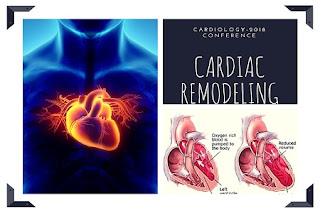Scifed International cardiology-2018 congress.
Cardiac Remodeling
Heart failure is associated with significant morbidity and
mortality attributable largely to cardiac structural changes with associated
cardiac dysfunction. Cardiac dysfunction is defined
as an alteration in the relationship between preload (often defined by left
ventricular filling pressure) and stroke volume. This relationship is depicted
by Frank-Starling curves, which identify a shift downward and to the right as
cardiac dysfunction.
Remodeling is defined as alteration in the structure
(dimensions, mass, shape) of the heart (called cardiac or ventricular
remodeling) in response to hemodynamic load and/or cardiac injury in association
with neurohormonal activation. Remodeling may be described as physiologic or
pathologic alternatively.
The injury is typically due
to acute myocardial
infarction (usually trans mural or ST
segment elevation infarction), but may be from a number of causes that result
in increased pressure or volume,
causing pressure overload or volume overload (forms of
strain) on the heart. Chronic hypertension, congenital heart disease with
intracardiac shunting, and valvular heart disease may also lead to
remodeling.
Mechanism and Treatment for Cardiac Remodeling:
The progression of heart failure is related to
cardiac remodeling, which represents the sequence of events at the molecular,
cellular and interstitial levels, leading to changes in the size, mass,
geometry and function of the heart. Cardiac remodeling involves both adaptive
and maladaptive phases of development. At the initial stage, it represents an
adaptive response to maintain cardiac output, whereas in the late stage, it
results in the occurrence of heart failure. Oxidative stress appears to be the
main factor that induces transition of cardiac hypertrophy to heart failure as
a consequence of alterations in signal transduction, dysfunction of the
sarcolemma and sarcoplasmic reticulum, impairment of calcium handling,
increases in cardiac The progression of heart failure is related to cardiac
remodeling, which represents the sequence of events at the molecular, cellular
and interstitial levels, leading to changes in the size, mass, geometry and
function of the heart. Cardiac remodeling involves both adaptive and
maladaptive phases of development. At the initial stage, it represents an
adaptive response to maintain cardiac output, whereas in the late stage, it
results in the occurrence of heart failure. Oxidative stress appears to be the
main factor that induces transition of cardiac hypertrophy to heart failure as
a consequence of alterations in signal transduction, dysfunction of the
sarcolemma and sarcoplasmic reticulum, impairment of calcium handling,
increases in cardiac The progression of heart failure is related to cardiac
remodeling, which represents the sequence of events at the molecular, cellular
and interstitial levels, leading to changes in the size, mass, geometry and
function of the heart. Cardiac remodeling involves both adaptive and maladaptive
phases of development. At the initial stage, it represents an adaptive response
to maintain cardiac output, whereas in the late stage, it results in the
occurrence of heart failure. Oxidative stress appears to be the main factor
that induces transition of cardiac hypertrophy to heart failure as a
consequence of alterations in signal transduction, dysfunction of the
sarcolemma and sarcoplasmic reticulum, impairment of calcium handling,
increases in cardiac fibrosis and progressive loss of cardiomyocytes. Elements
that play a fundamental role at the initial stages of cardiac remodeling and
are associated with cardiac hypertrophy include neurohormonal activation,
represented by the elevation of angiotensin II and norepinephrine levels. On
the other hand, prolonged neurohormonal activation, as well as inflammatory
signaling due to increased levels of tumor necrosis factor-α and transforming
growth factor-β, may be involved in the late stages of cardiac remodeling
associated with heart failure. In its initial stages, cardiac remodeling
appears to serve as an adaptive mechanism, whereas in its late stages this
process is associated with molecular and cellular defects leading to the
development of heart failure.
2nd
International Congress and Expo on Cardiology providing
excellent opportunity to be as a Speaker on this esteemed congress to speak few
words on the topic “Cardiac Remodeling”.
The conference is going to be held at Toronto, Canada during September
20-21, 2018.
Toronto Highlights are
shown below:
For more details, PS: http://scientificfederation.com/cardiology-2018/
.png)






1 comments: